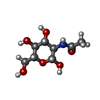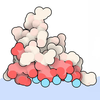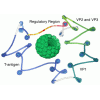[English] 日本語
 Yorodumi
Yorodumi- EMDB-48522: Vitamin K-dependent gamma-carboxylase with Osteocalcin and vitami... -
+ Open data
Open data
- Basic information
Basic information
| Entry |  | ||||||||||||||||||||||||
|---|---|---|---|---|---|---|---|---|---|---|---|---|---|---|---|---|---|---|---|---|---|---|---|---|---|
| Title | Vitamin K-dependent gamma-carboxylase with Osteocalcin and vitamin K hydroquinone | ||||||||||||||||||||||||
 Map data Map data | 3.56A cryoEM structure of Vitamin K-dependent gamma-carboxylase with Osteocalcin and vitamin K hydroquinone | ||||||||||||||||||||||||
 Sample Sample |
| ||||||||||||||||||||||||
 Keywords Keywords | GGCX / VKGC / Vitamin K / VKCFD / Hemophilia B / Warfarin / Carboxylation / Blood Coagulation / Calcium homeostasis / Osteocalcin / MEMBRANE PROTEIN / TRANSFERASE | ||||||||||||||||||||||||
| Function / homology |  Function and homology information Function and homology informationresponse to hydroxyisoflavone / hydroxyapatite binding / structural constituent of bone / peptidyl-glutamate 4-carboxylase / gamma-glutamyl carboxylase activity / negative regulation of testosterone biosynthetic process / cellular response to zinc ion starvation / negative regulation of bone development / response to macrophage colony-stimulating factor / Defective gamma-carboxylation of F9 ...response to hydroxyisoflavone / hydroxyapatite binding / structural constituent of bone / peptidyl-glutamate 4-carboxylase / gamma-glutamyl carboxylase activity / negative regulation of testosterone biosynthetic process / cellular response to zinc ion starvation / negative regulation of bone development / response to macrophage colony-stimulating factor / Defective gamma-carboxylation of F9 / vitamin binding / vitamin K metabolic process / regulation of testosterone biosynthetic process / response to vitamin K / negative regulation of neurotransmitter secretion / regulation of osteoclast differentiation / cellular response to vitamin D / regulation of bone mineralization / type B pancreatic cell proliferation / regulation of bone resorption / osteoblast development / response to vitamin D / response to zinc ion / positive regulation of neurotransmitter secretion / response to testosterone / response to gravity / bone mineralization / RUNX2 regulates osteoblast differentiation / response to mechanical stimulus / Transport of gamma-carboxylated protein precursors from the endoplasmic reticulum to the Golgi apparatus / Gamma-carboxylation of protein precursors / Removal of aminoterminal propeptides from gamma-carboxylated proteins / regulation of cellular response to insulin stimulus / response to glucocorticoid / protein maturation / response to activity / skeletal system development / stem cell differentiation / hormone activity / bone development / brain development / protein modification process / cellular response to growth factor stimulus / Golgi lumen / response to estrogen / cognition / cellular response to insulin stimulus / blood coagulation / osteoblast differentiation / glucose homeostasis / response to ethanol / perikaryon / vesicle / learning or memory / cell adhesion / response to xenobiotic stimulus / endoplasmic reticulum lumen / calcium ion binding / dendrite / endoplasmic reticulum membrane / structural molecule activity / extracellular space / extracellular region / membrane / cytoplasm Similarity search - Function | ||||||||||||||||||||||||
| Biological species |  Homo sapiens (human) Homo sapiens (human) | ||||||||||||||||||||||||
| Method | single particle reconstruction / cryo EM / Resolution: 3.56 Å | ||||||||||||||||||||||||
 Authors Authors | Li W / Liu B / Cao Q | ||||||||||||||||||||||||
| Funding support |  United States, 7 items United States, 7 items
| ||||||||||||||||||||||||
 Citation Citation |  Journal: Cell Res / Year: 2025 Journal: Cell Res / Year: 2025Title: Structural insights into the vitamin K-dependent γ-carboxylation of osteocalcin. Authors: Qing Cao / Jianjun Fan / Aaron Ammerman / Samjhana Awasthi / Zongtao Lin / Saimi Mierxiati / Huaping Chen / Jinbin Xu / Benjamin A Garcia / Bin Liu / Weikai Li /  Abstract: The γ-carboxylation state of osteocalcin determines its essential functions in bone mineralization or systemic metabolism and serves as a prominent biomarker for bone health and vitamin K nutrition. ...The γ-carboxylation state of osteocalcin determines its essential functions in bone mineralization or systemic metabolism and serves as a prominent biomarker for bone health and vitamin K nutrition. This post-translational modification of glutamate residues is catalyzed by the membrane-embedded vitamin K-dependent γ-carboxylase (VKGC), which typically recognizes protein substrates through their tightly bound propeptide that triggers γ-carboxylation. However, the osteocalcin propeptide exhibits negligible affinity for VKGC. To understand the underlying molecular mechanism, we determined the cryo-electron microscopy structures of VKGC with osteocalcin carrying a native propeptide or a high-affinity variant at different carboxylation states. The structures reveal a large chamber in VKGC that maintains uncarboxylated and partially carboxylated osteocalcin in partially unfolded conformations, allowing their glutamate-rich region and C-terminal helices to engage with VKGC at multiple sites. Binding of this mature region together with the low-affinity propeptide effectively stimulates VKGC activity, similar to high-affinity propeptides that differ only in closely fitting interactions. However, the low-affinity propeptide renders osteocalcin prone to undercarboxylation at low vitamin K levels, thereby serving as a discernible biomarker. Overall, our studies reveal the unique interaction of osteocalcin with VKGC and provide a framework for designing therapeutic strategies targeting osteocalcin-related bone and metabolic disorders. | ||||||||||||||||||||||||
| History |
|
- Structure visualization
Structure visualization
| Supplemental images |
|---|
- Downloads & links
Downloads & links
-EMDB archive
| Map data |  emd_48522.map.gz emd_48522.map.gz | 89.8 MB |  EMDB map data format EMDB map data format | |
|---|---|---|---|---|
| Header (meta data) |  emd-48522-v30.xml emd-48522-v30.xml emd-48522.xml emd-48522.xml | 23.9 KB 23.9 KB | Display Display |  EMDB header EMDB header |
| FSC (resolution estimation) |  emd_48522_fsc.xml emd_48522_fsc.xml | 11.9 KB | Display |  FSC data file FSC data file |
| Images |  emd_48522.png emd_48522.png | 55.1 KB | ||
| Filedesc metadata |  emd-48522.cif.gz emd-48522.cif.gz | 7.4 KB | ||
| Others |  emd_48522_half_map_1.map.gz emd_48522_half_map_1.map.gz emd_48522_half_map_2.map.gz emd_48522_half_map_2.map.gz | 165.1 MB 165.1 MB | ||
| Archive directory |  http://ftp.pdbj.org/pub/emdb/structures/EMD-48522 http://ftp.pdbj.org/pub/emdb/structures/EMD-48522 ftp://ftp.pdbj.org/pub/emdb/structures/EMD-48522 ftp://ftp.pdbj.org/pub/emdb/structures/EMD-48522 | HTTPS FTP |
-Related structure data
| Related structure data |  9mqeMC  9mqbC  9mqcC M: atomic model generated by this map C: citing same article ( |
|---|---|
| Similar structure data | Similarity search - Function & homology  F&H Search F&H Search |
- Links
Links
| EMDB pages |  EMDB (EBI/PDBe) / EMDB (EBI/PDBe) /  EMDataResource EMDataResource |
|---|---|
| Related items in Molecule of the Month |
- Map
Map
| File |  Download / File: emd_48522.map.gz / Format: CCP4 / Size: 178 MB / Type: IMAGE STORED AS FLOATING POINT NUMBER (4 BYTES) Download / File: emd_48522.map.gz / Format: CCP4 / Size: 178 MB / Type: IMAGE STORED AS FLOATING POINT NUMBER (4 BYTES) | ||||||||||||||||||||||||||||||||||||
|---|---|---|---|---|---|---|---|---|---|---|---|---|---|---|---|---|---|---|---|---|---|---|---|---|---|---|---|---|---|---|---|---|---|---|---|---|---|
| Annotation | 3.56A cryoEM structure of Vitamin K-dependent gamma-carboxylase with Osteocalcin and vitamin K hydroquinone | ||||||||||||||||||||||||||||||||||||
| Projections & slices | Image control
Images are generated by Spider. | ||||||||||||||||||||||||||||||||||||
| Voxel size | X=Y=Z: 0.664 Å | ||||||||||||||||||||||||||||||||||||
| Density |
| ||||||||||||||||||||||||||||||||||||
| Symmetry | Space group: 1 | ||||||||||||||||||||||||||||||||||||
| Details | EMDB XML:
|
-Supplemental data
-Half map: half map B
| File | emd_48522_half_map_1.map | ||||||||||||
|---|---|---|---|---|---|---|---|---|---|---|---|---|---|
| Annotation | half map B | ||||||||||||
| Projections & Slices |
| ||||||||||||
| Density Histograms |
-Half map: half map A
| File | emd_48522_half_map_2.map | ||||||||||||
|---|---|---|---|---|---|---|---|---|---|---|---|---|---|
| Annotation | half map A | ||||||||||||
| Projections & Slices |
| ||||||||||||
| Density Histograms |
- Sample components
Sample components
-Entire : Vitamin K-dependent gamma-carboxylase with Osteocalcin and vitami...
| Entire | Name: Vitamin K-dependent gamma-carboxylase with Osteocalcin and vitamin K hydroquinone |
|---|---|
| Components |
|
-Supramolecule #1: Vitamin K-dependent gamma-carboxylase with Osteocalcin and vitami...
| Supramolecule | Name: Vitamin K-dependent gamma-carboxylase with Osteocalcin and vitamin K hydroquinone type: complex / ID: 1 / Parent: 0 / Macromolecule list: #1-#2 |
|---|---|
| Source (natural) | Organism:  Homo sapiens (human) Homo sapiens (human) |
| Molecular weight | Theoretical: 110 KDa |
-Macromolecule #1: Vitamin K-dependent gamma-carboxylase
| Macromolecule | Name: Vitamin K-dependent gamma-carboxylase / type: protein_or_peptide / ID: 1 / Number of copies: 1 / Enantiomer: LEVO / EC number: peptidyl-glutamate 4-carboxylase |
|---|---|
| Source (natural) | Organism:  Homo sapiens (human) Homo sapiens (human) |
| Molecular weight | Theoretical: 87.655641 KDa |
| Recombinant expression | Organism:  Homo sapiens (human) Homo sapiens (human) |
| Sequence | String: MAVSAGSART SPSSDKVQKD KAELISGPRQ DSRIGKLLGF EWTDLSSWRR LVTLLNRPTD PASLAVFRFL FGFLMVLDIP QERGLSSLD RKYLDGLDVC RFPLLDALRP LPLDWMYLVY TIMFLGALGM MLGLCYRISC VLFLLPYWYV FLLDKTSWNN H SYLYGLLA ...String: MAVSAGSART SPSSDKVQKD KAELISGPRQ DSRIGKLLGF EWTDLSSWRR LVTLLNRPTD PASLAVFRFL FGFLMVLDIP QERGLSSLD RKYLDGLDVC RFPLLDALRP LPLDWMYLVY TIMFLGALGM MLGLCYRISC VLFLLPYWYV FLLDKTSWNN H SYLYGLLA FQLTFMDANH YWSVDGLLNA HRRNAHVPLW NYAVLRGQIF IVYFIAGVKK LDADWVEGYS MEYLSRHWLF SP FKLLLSE ELTSLLVVHW GGLLLDLSAG FLLFFDVSRS IGLFFVSYFH CMNSQLFSIG MFSYVMLASS PLFCSPEWPR KLV SYCPRR LQQLLPLKAA PQPSVSCVYK RSRGKSGQKP GLRHQLGAAF TLLYLLEQLF LPYSHFLTQG YNNWTNGLYG YSWD MMVHS RSHQHVKITY RDGRTGELGY LNPGVFTQSR RWKDHADMLK QYATCLSRLL PKYNVTEPQI YFDIWVSIND RFQQR IFDP RVDIVQAAWS PFQRTSWVQP LLMDLSPWRA KLQEIKSSLD NHTEVVFIAD FPGLHLENFV SEDLGNTSIQ LLQGEV TVE LVAEQKNQTL REGEKMQLPA GEYHKVYTTS PSPSCYMYVY VNTTELALEQ DLAYLQELKE KVENGSETGP LPPELQP LL EGEVKGGPEP TPLVQTFLRR QQRLQEIERR RNTPFHERFF RFLLRKLYVF RRSFLMTCIS LRNLILGRPS LEQLAQEV T YANLRPFEAV GELNPSNTDS SHSNPPESNP DPVHSEF UniProtKB: Vitamin K-dependent gamma-carboxylase |
-Macromolecule #2: Osteocalcin
| Macromolecule | Name: Osteocalcin / type: protein_or_peptide / ID: 2 / Number of copies: 1 / Enantiomer: LEVO |
|---|---|
| Source (natural) | Organism:  Homo sapiens (human) Homo sapiens (human) |
| Molecular weight | Theoretical: 10.975558 KDa |
| Recombinant expression | Organism:  Homo sapiens (human) Homo sapiens (human) |
| Sequence | String: MRALTLLALL ALAALCIAGQ AGAKPSGAES SKGAAFVSKQ EGSEVVKRPR RYLYQWLGAP VPYPDPLEPR REVCELNPDC DELADHIGF QEAYRRFYGP V UniProtKB: Osteocalcin |
-Macromolecule #4: 2-acetamido-2-deoxy-beta-D-glucopyranose
| Macromolecule | Name: 2-acetamido-2-deoxy-beta-D-glucopyranose / type: ligand / ID: 4 / Number of copies: 3 / Formula: NAG |
|---|---|
| Molecular weight | Theoretical: 221.208 Da |
| Chemical component information |  ChemComp-NAG: |
-Macromolecule #5: (4S,7R)-4-HYDROXY-N,N,N-TRIMETHYL-9-OXO-7-[(PALMITOYLOXY)METHYL]-...
| Macromolecule | Name: (4S,7R)-4-HYDROXY-N,N,N-TRIMETHYL-9-OXO-7-[(PALMITOYLOXY)METHYL]-3,5,8-TRIOXA-4-PHOSPHAHEXACOSAN-1-AMINIUM 4-OXIDE type: ligand / ID: 5 / Number of copies: 2 / Formula: 6PL |
|---|---|
| Molecular weight | Theoretical: 763.1 Da |
| Chemical component information |  ChemComp-6PL: |
-Macromolecule #6: vitamin K1 hydroquinone
| Macromolecule | Name: vitamin K1 hydroquinone / type: ligand / ID: 6 / Number of copies: 1 / Formula: A1AVC |
|---|---|
| Molecular weight | Theoretical: 452.712 Da |
-Experimental details
-Structure determination
| Method | cryo EM |
|---|---|
 Processing Processing | single particle reconstruction |
| Aggregation state | particle |
- Sample preparation
Sample preparation
| Buffer | pH: 7.5 Component:
| ||||||||||||||||||
|---|---|---|---|---|---|---|---|---|---|---|---|---|---|---|---|---|---|---|---|
| Grid | Model: Quantifoil R1.2/1.3 / Material: COPPER / Mesh: 300 / Support film - Material: CARBON / Support film - topology: HOLEY / Support film - Film thickness: 10 / Pretreatment - Type: GLOW DISCHARGE / Pretreatment - Time: 60 sec. | ||||||||||||||||||
| Vitrification | Cryogen name: ETHANE / Chamber humidity: 95 % / Chamber temperature: 283.15 K / Instrument: LEICA EM GP |
- Electron microscopy
Electron microscopy
| Microscope | TFS KRIOS |
|---|---|
| Temperature | Min: 63.0 K / Max: 77.0 K |
| Specialist optics | Energy filter - Name: GIF Bioquantum / Energy filter - Slit width: 20 eV |
| Software | Name: EPU |
| Image recording | Film or detector model: GATAN K3 BIOQUANTUM (6k x 4k) / Digitization - Dimensions - Width: 4092 pixel / Digitization - Dimensions - Height: 5760 pixel / Number grids imaged: 1 / Number real images: 7089 / Average electron dose: 47.0 e/Å2 |
| Electron beam | Acceleration voltage: 300 kV / Electron source:  FIELD EMISSION GUN FIELD EMISSION GUN |
| Electron optics | C2 aperture diameter: 50.0 µm / Illumination mode: FLOOD BEAM / Imaging mode: BRIGHT FIELD / Cs: 2.7 mm / Nominal defocus max: 2.0 µm / Nominal defocus min: 1.0 µm / Nominal magnification: 130000 |
| Sample stage | Specimen holder model: FEI TITAN KRIOS AUTOGRID HOLDER / Cooling holder cryogen: NITROGEN |
| Experimental equipment |  Model: Titan Krios / Image courtesy: FEI Company |
+ Image processing
Image processing
-Atomic model buiding 1
| Refinement | Space: REAL / Protocol: OTHER |
|---|---|
| Output model |  PDB-9mqe: |
 Movie
Movie Controller
Controller













 Z (Sec.)
Z (Sec.) Y (Row.)
Y (Row.) X (Col.)
X (Col.)





































